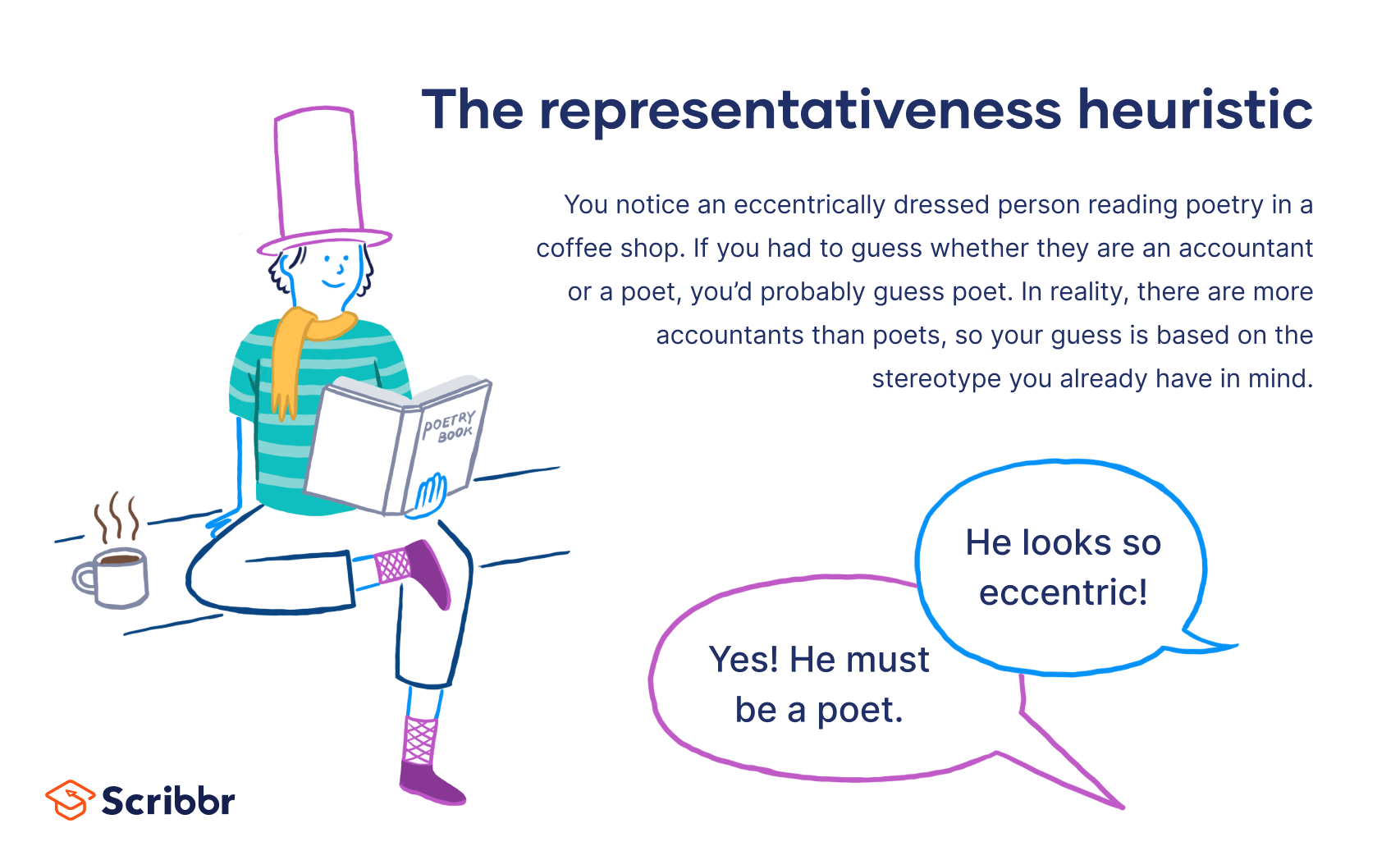Representativeness Heuristic | Example & Definition
The representativeness heuristic occurs when we estimate the probability of an event based on how similar it is to a known situation. In other words, we compare it to a situation, prototype, or stereotype we already have in mind.
Although representativeness provides a quick and efficient way to make decisions, it can cause us to overlook important information and draw incorrect conclusions.
What is the representativeness heuristic?
The representativeness heuristic is a type of cognitive bias or mental shortcut. Just like other types of heuristics, such as the availability heuristic and anchoring bias, it can help us reduce the time and effort needed to make reasonably good judgments. At the same time, it can lead us astray because we only pay attention to a subset of information: in this case, similarity.
Under the representativeness heuristic, we estimate the probability of something belonging to a specific category based on the degree to which it resembles (or is representative of) the typical or average member of the category. This is called a prototype.
The problem with the representativeness heuristic is that we are unlikely to consider probabilistic or logical relationships between A and B when we have to answer questions like ‘What is the likelihood that A belongs to/originates from/generates B?’ Rather, we judge based on whether A is representative of (meaning ‘similar to’) B.
In other words, the representativeness heuristic uses similarity instead of more complex probabilistic and logical explanations. For this reason, it can lead us to irrational biases, such as prejudice and stereotyping.
Why does the representativeness heuristic occur?
There are a few reasons that can explain why we draw on the representativeness heuristic to make judgments:
- We use mental shortcuts or heuristics to solve problems. Just like with other types of heuristics, our brains are constantly trying to save us time and effort while navigating a complex world. For this reason, we use simple strategies or rules of thumb to assess information and generate quick responses in everyday tasks. Although heuristics yield fairly good responses, the downside is that they often cause us to oversimplify reality.
- We rely on categories to make sense of the world around us. Categories help us organize and interpret the vast amount of information available in our environment. These categories are built around certain prototypes of what the average member of the category looks like. For example, we recognize a snake when we see one, even if we don’t know exactly what type of snake it is. Intuitively, we know we should be careful. By grouping similar things together, we draw on our knowledge of the category and immediately know what to do.
- We overestimate the importance of similarity and ignore more relevant information. Reliance on similarity leads people to ignore ‘base rate’ information, or how often an event occurs. For example, when asked to categorise a person as an engineer or a lawyer, most people would immediately categorise that person as an engineer if they were told that the person enjoyed physics at school – even if they knew that the person was drawn from a population consisting of 90% lawyers and 10% engineers.
Representativeness heuristic example
Under the representativeness heuristic, specific scenarios appear more likely than general ones because they are more representative of how we imagine particular events.
Tom is 34 years old. He is intelligent but rather unimaginative, and he collects old jazz records. In school, he was strong in mathematics but weak in social sciences and humanities.
Which statement is more probable:
A. Tom is an accountant that plays the trumpet for a hobby
B. Tom plays the trumpet for a hobby
Given the description, you might feel that A is a more accurate answer. However, this violates a fundamental rule of probability. The conjunction, or co-occurrence, of two events (e.g., ‘accountant’ and ‘trumpet player’) cannot be more likely than the probability of either event alone.
As the amount of detail in a scenario increases, its probability can only decrease steadily, but its representativeness (and thus its apparent likelihood) may increase.
This particular problem of representativeness is also known as conjunction fallacy.
Representativeness heuristic vs availability heuristic
Although both the representativeness heuristic and the availability heuristic play a role in our decision-making and help us estimate how likely something is, they are two different types of heuristics.
- The representativeness heuristic is a mental shortcut for judging the probability of an outcome in terms of how well it seems to represent or match a particular prototype.
- The availability heuristic is a mental shortcut for judging the probability of an outcome in terms of how easy it is to bring similar outcomes to mind.
In other words, representativeness causes us to miscalculate probability by paying more attention to similarity, while availability causes us to focus on ease of recall.
Other types of research bias
Frequently asked questions
Sources for this article
We strongly encourage students to use sources in their work. You can cite our article (APA Style) or take a deep dive into the articles below.
This Scribbr articleNikolopoulou, K. (2024, February 05). Representativeness Heuristic | Example & Definition. Scribbr. Retrieved 2 April 2025, from https://www.scribbr.co.uk/bias-in-research/the-representativeness-heuristic/
Bhatia, S. (2015). The Power of the Representativeness Heuristic. Cognitive Science.
Plous, S. (1993). The psychology of judgment and decision making. Mcgraw-Hill Book Company. pp. 109-120

